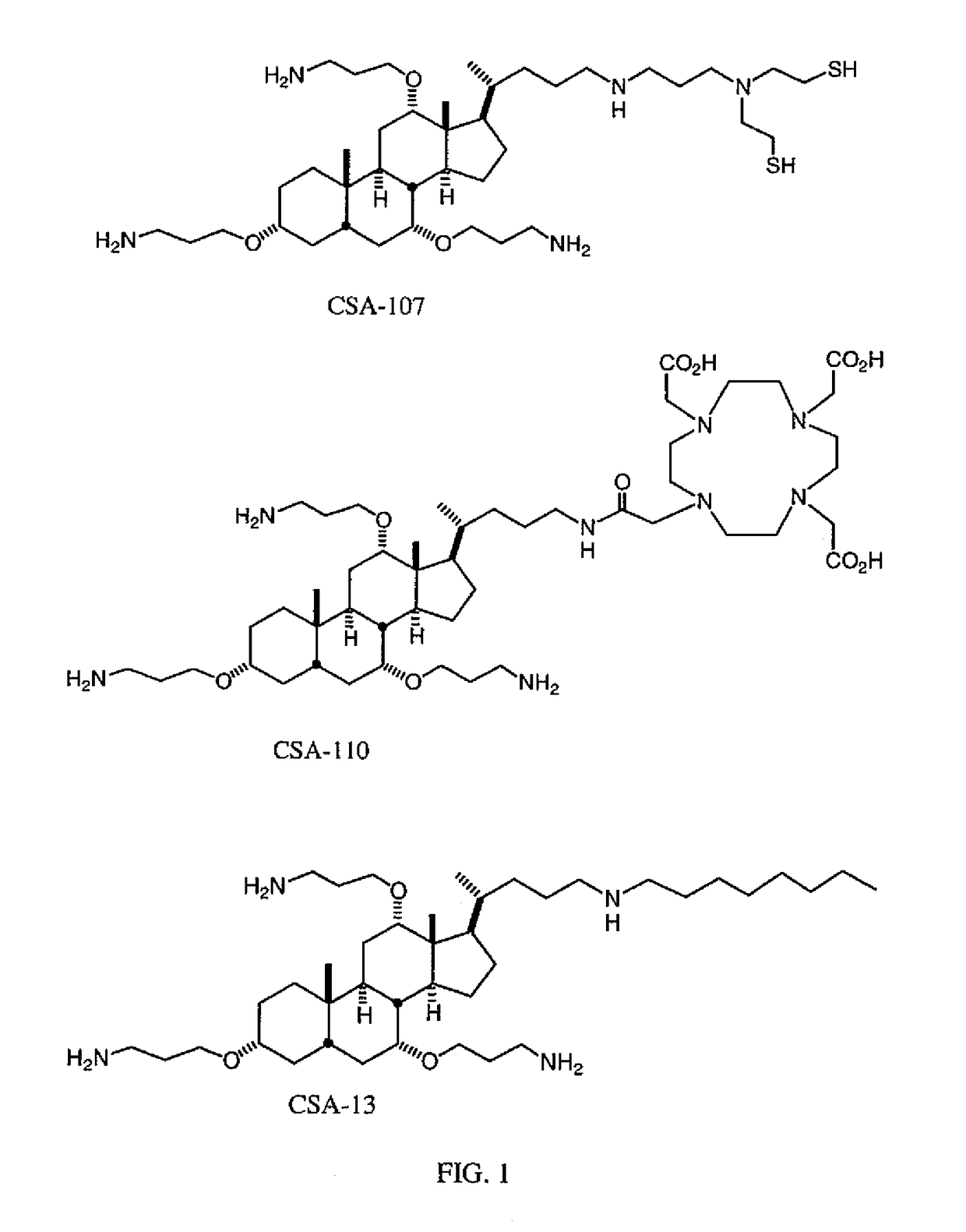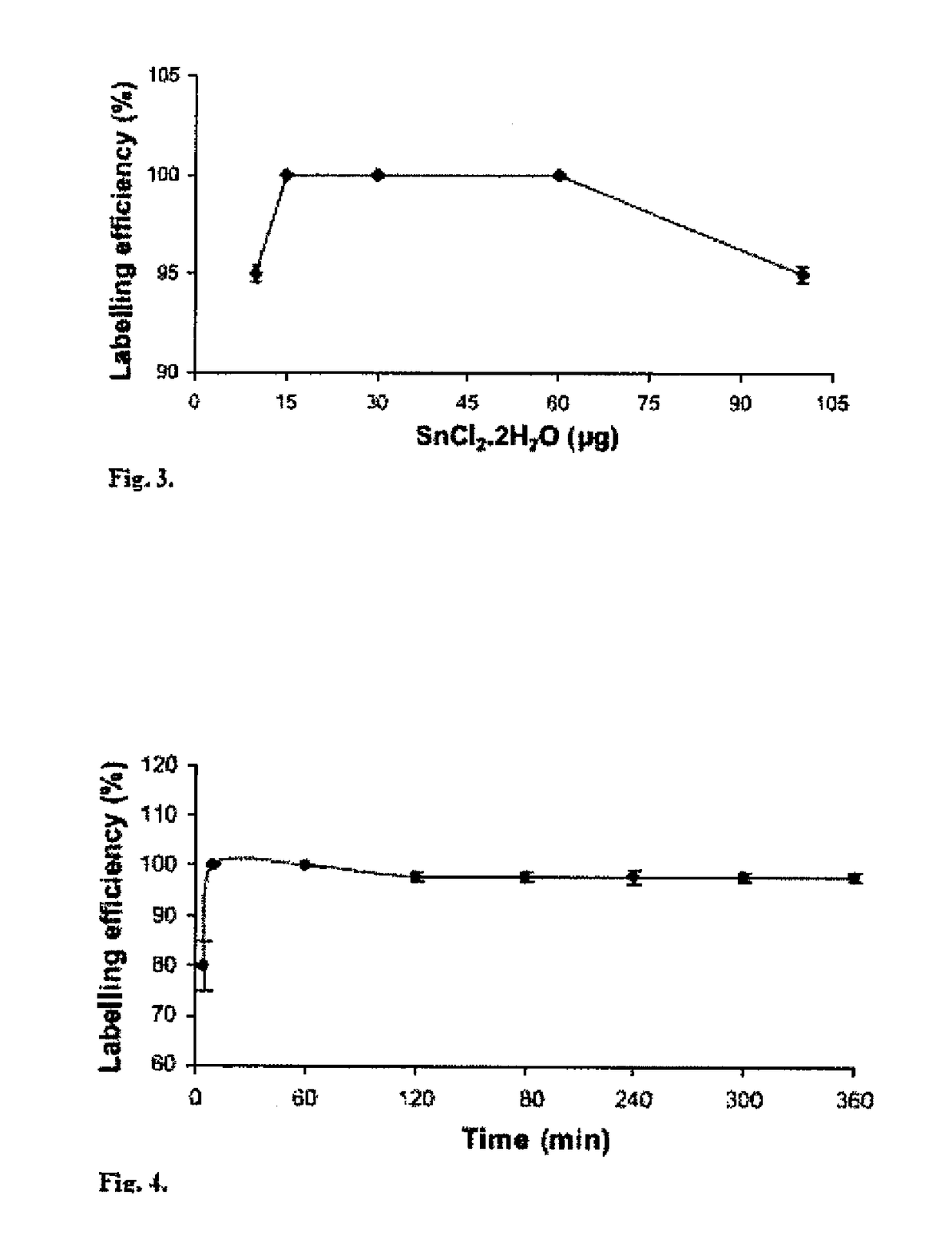Cationic steroid antimicrobial diagnostic, detection, screening and imaging methods
a technology of cationic steroid and antimicrobial, applied in the field of diagnostic, detection, screening and imaging methods, can solve problems such as rapid cell death
- Summary
- Abstract
- Description
- Claims
- Application Information
AI Technical Summary
Benefits of technology
Problems solved by technology
Method used
Image
Examples
example 1
This example includes a description of various Materials and Methods.
[0150]CSA-13 was obtained from the Paul B. Savage laboratory, Department of Chemistry and Biochemistry, Brigham Young University, C100 BNSN, Provo, Utah 84602. Rats (Sprague-Dawley) and staphylococcus aureus bacteria (American type culture collection, ATCC 25923) were obtained from the National Institute of Health (NIH) Islamabad. The Animal ethics Committee of Institute gave an ethical approval for the animal studies. 99mTc was obtained from locally produced fission based PAKGEN 99Mo / 99mTc generator system. All the chemicals used were AR grade and purchased from Merck., Germany. Freeze dried kits of DTPA and Ciprofloxacin were obtained from “Kit Production Group”, PINSTECH, Islamabad.
Radiolabeling of DTPA, Ciprofloxacin and CSA-13
[0151]DTPA kits contain 10 mg of diethylene triamine pentaacetic acid, 0.4 mg of SnCl2.2H2O and NaOH to make pH 7. 1.0 ml of Na99mTcO4 (8-10 mCi) was then added and incubated at room temp...
example 2
This example includes a description of one or more exemplary synthestic procedures for obtaining Compounds 3, 28 and 29.
[0191]Compound 28: A suspension of 19 (0.641 g, 0.614 mmol) and KCN (0.40 g, 6.14 mmol) in anhydrous DMSO (5 mL) was stirred under N2 at 80° C. overnight followed by the addition of H2O (50 mL). The aqueous mixture was extracted with EtOAc (4×20 mL). The combined extracts were washed with brine once, dried over anhydrous Na2SO4 and concentrated in vacuo. The residue was dissolved in CH2Cl2 (3 mL) and MeOH (3 mL) and catalytic amount of p-toluenesulfonic acid (5.84 mg, 0.03 mmol) was added. The solution was stirred at room temperature for 3 hours before the introduction of saturated NaHCO3 solution (10 mL). After the addition of brine (60 mL), the mixture was extracted with EtOAc (4×30 mL). The combined extracts were washed with brine once and dried over anhydrous Na2SO4 and concentrated. The residue afforded the desired product (0.342 g, 92% yield) as pale yellowis...
example 3
This example includes a description of one or more exemplary synthestic procedures for obtaining Compounds 6, 7 and 30-33.
[0194]Compound 30: Cholic acid (3.0 g, 7.3 mmol) was dissolved in CH2Cl2 (50 mL) and methanol (5 mL). Dicyclohexylcarbodiimide (DCC) (1.8 g, 8.8 mmol) was added followed by N-hydroxysuccinimide (about 100 mg) and benzylmethylamine (1.1 g, 8.8 mmol). The mixture was stirred for 2 hours, then filtered. The filtrate was concentrated and chromatographed (SiO2, 3% MeOH in CH2Cl2) to give 3.0 g of a white solid (81% yield). m.p. 184-186° C.; IR (neat) 3325, 2984, 1678 cm−1; 1H NMR (CDCl3, 200 MHz) δ 7.21 (m, 5 H), 4.51 (m, 2 H), 3.87 (m, 1 H), 3.74 (m, 2 H), 3.36 (m, 2 H), 2.84 (s, 3 H), 2.48-0.92 (series of multiplets, 28 H), 0.80 (s, 3 H), 0.58 (d, J=6.5 Hz, 3 H); 13C NMR (CDCl3, 50 MHz) δ 174.30, 173.94, 137.36, 136.63, 128.81, 128.46, 127.85, 127.50, 127.18, 126.28, 72.96, 71.76, 68.35, 53.39, 50.65, 48.77, 46.91, 46.33, 41.44, 39.36, 39.18, 35.76, 35.27, 34.76, 33...
PUM
 Login to View More
Login to View More Abstract
Description
Claims
Application Information
 Login to View More
Login to View More - R&D
- Intellectual Property
- Life Sciences
- Materials
- Tech Scout
- Unparalleled Data Quality
- Higher Quality Content
- 60% Fewer Hallucinations
Browse by: Latest US Patents, China's latest patents, Technical Efficacy Thesaurus, Application Domain, Technology Topic, Popular Technical Reports.
© 2025 PatSnap. All rights reserved.Legal|Privacy policy|Modern Slavery Act Transparency Statement|Sitemap|About US| Contact US: help@patsnap.com



